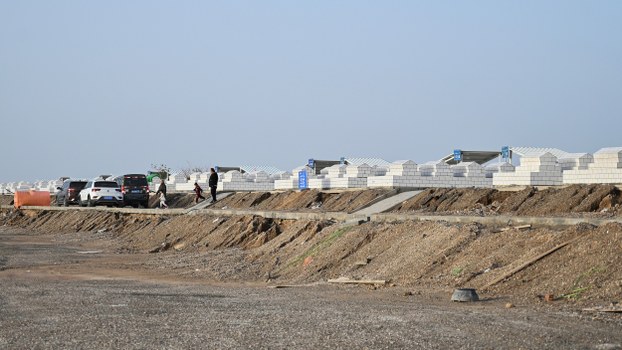Two internment camps recently identified by satellite imagery in northwest China’s Xinjiang Uyghur Autonomous Region (XUAR) appear to be separated by a cemetery and crematorium, raising fears that authorities are working to cover up deaths in the facilities.
Earlier this week, Bahtiyar Omar, the director of the Norway-based Uyghur Transitional Justice Database (UTJD), provided RFA’s Uyghur Service with images from Google Earth Pro that clearly show the construction of camps and associated factories outside of the seat of the XUAR’s Aksu (in Chinese, Akesu) prefecture between 2017 and 2019.
The camps are part of a vast network of similar facilities throughout the XUAR where regional authorities are believed to have held up to 1.8 million Uyghurs and other Muslim minorities since early 2017. Amid increasing international scrutiny, authorities have begun to send detainees to work at nearby factories as part of an effort to label the camps “vocational centers,” although those held in the facilities regularly toil under forced or coerced labor conditions.
Based on the imagery provided by Omar, construction on the two camps outside of Aksu—a city of 660,000 people on the northern edge of the Taklamakan Desert—began in 2017, while the factory facility appeared nearby in 2018.
“These photos are irrefutable proof that that the centers for so-called ‘voluntary re-education’ and ‘vocational education’ in the Uyghur Region are not merely camps that are managed in the style of prisons but also that China’s camp policies have been combined with forced labor from 2018 onward,” Omar told RFA.
Additionally, he pointed out imagery that showed a large cemetery located within a kilometer of the two camps containing a large building and parking lot—sometimes containing dozens of white cars—that were built in the middle of the grounds in 2017.
“[The structure] appears to be several stories, and it’s large in size,” he said. “If a crematorium is located in this building, it does not seem a coincidence that it would be located between two camps.”
Adrian Zenz, a senior fellow at the Washington-based Victims of Communism Memorial Foundation and a leading expert on China’s policies toward Uyghurs, recently tweeted a new satellite image of one of the Aksu camps, which he described as a “100,000sqm internment camp & factory compound” and shows detainees lined up in the yard.
“These pictures of more than 1,000 orange-clad inmates lined up in front of the camp and the factory building are very important evidence of the ongoing forced labor in the Uyghur region,” he told RFA in an interview, providing additional context for the images.
Zenz also noted the structure identified by Omar within the nearby cemetery, expressing concern that there might be a cremation site near the camps and that authorities might be “trying to conceal” deaths in the camps.
He noted that detainees often include the elderly, who are more at risk of developing conditions that can lead to death if not properly treated, and cited witness testimonies from family members of those who died in the camps that described how relatives are given cremated remains.
“The funeral was done in a very concealed and harsh way,” he said of the testimonies.
“They don’t want any sort of mourning. I think that’s just quite concerning and part of the whole suppression, also the emotional suppression of what’s going on.”

